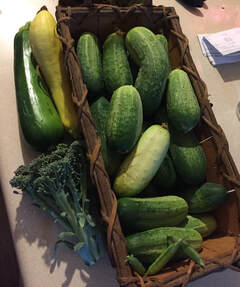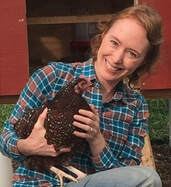
I ended up with about twice as many cucumber plants as we needed this year, as my first planting didn't come up well, so I planted extra the second time, and they ALL came up! I thinned them out pretty heavily, but we still ended up with 6 or 7 cucumbers plants. Since these are the extremely prolific Boston pickling variety, we really only need 4 plants maximum - and that's if we want to can a lot of pickles.
Needless to say, we are swimming in cucumbers this summer! I pick a colander full almost daily, and we've been eating variations on cucumber salad several times per week, giving them away, and of course, making pickles! I usually can a few batches when we have a lot, as we only grow cucumbers every few years due to pests, and they will last us a couple of years.
This weekend was dill pickles - whole, spears, and hamburger slices. Next weekend will be the classic bread & butter pickles (my favorite), and I may even try a new sweet and spicy variety if they continue producing heavily like this.
I also love naturally fermented pickles, and was amazed to discover that, although I have shared many natural fermentation recipes here, I've never shared a recipe for lacto-fermented cucumber pickles. While these do need to be refrigerated once they have fermented to your taste (so you can't make gallons of them), they are so tasty you may just have a new batch going every week while the cucumbers last! Below is the simple recipe I use.
This makes a fairly large 2-quart batch. If you are making a smaller batch, you can adjust the ingredients accordingly, just making sure to keep your ratios of salt and water the same.
You will also need wide-mouth quart jars (or other fermentation vessel), fermentation weights, and air locks.
Garlicky Lacto-Fermented Dill Pickles
Makes 2 quarts
Time: 15 minutes active + 30-minutes soaking + 4-7 days fermentation
Ingredients:
- 2 lbs small pickling cucumbers
- 2 TB garlic cloves, sliced
- 2 cups packed fresh dill (or 1 1/2 cups frozen), or 2 large fresh dill flower heads
- Pickling spice blend of your choice (I just use 1 tsp whole black peppercorns and 1 tsp whole mustard seed)
Brine:
- 4 cups triple-filtered or bottled (NON-CHLORINATED) water
- 2 TB unrefined sea salt (I use Celtic grey)
Directions:
- Wash the cucumbers and soak them whole in a bowl containing 1 quart of cold water mixed with 1/3 cup inexpensive sea salt (no need to use the good stuff here).
- Meanwhile, make your brine by dissolving the unrefined sea salt in the 4 cups of non-chlorinated water and set aside.
- When cucumbers are done soaking, lightly scrub and rinse them, and cut off both ends. Discard the ends, as these will make your pickles mushy. (Our chickens love the scraps!)
- Divide your pickling spices evenly between your fermentation vessels, and lay them on their sides. Place the cucumbers into your vessel(s), leaving space in the center, and be sure to leave about 2" head space in each container.
- Stand the jars upright and pack the dill and sliced garlic into the remaining space(s).
- Pour your prepared brine in to cover, making sure to leave 1" or so of space at the top of your container. (Note: Unrefined sea salt can often contain some grit, so I always throw away the last little bit that is left at the bottom of the brine - otherwise your pickles may end up gritty.)
- Install your fermentation weights (or cup, if you're using the Perfect Pickler kit), place your lids on, and install your air lock(s).
- Place in an out-of-the way location between 70-75 degrees F.
- Wait. :-)
Your pickles should take about 4-7 days to ferment, depending on the temperature. (If it's below 70 degrees F. it may take a bit longer.) I usually start tasting around Day 5. If they're not quite sour enough, let them go a day or two longer. However, keep in mind that these will never be as sour as vinegar pickles. If you would like them to taste more like a "full sour" pickle, add 3-4 TB apple cider vinegar AFTER the fermentation is complete.
Once they are done, remove the air lock, add a lid, and refrigerate. Enjoy within 2-3 weeks.
If you like this recipe, please share on Facebook and Twitter, and let us know how it turned out for you!
Rose.



 RSS Feed
RSS Feed